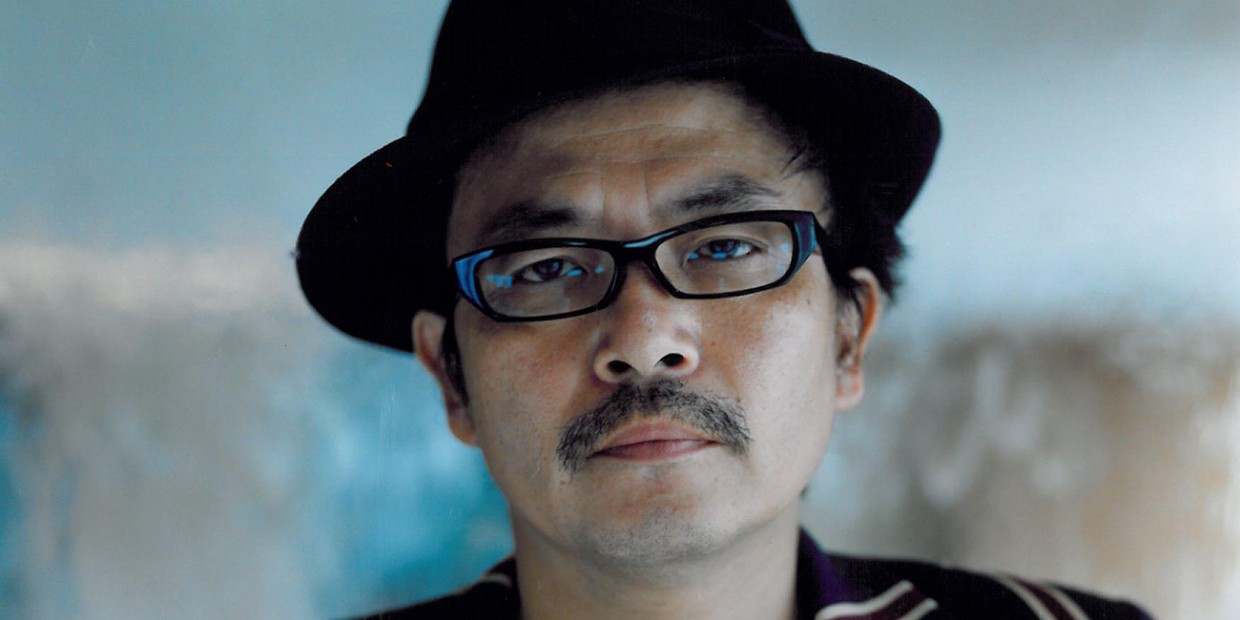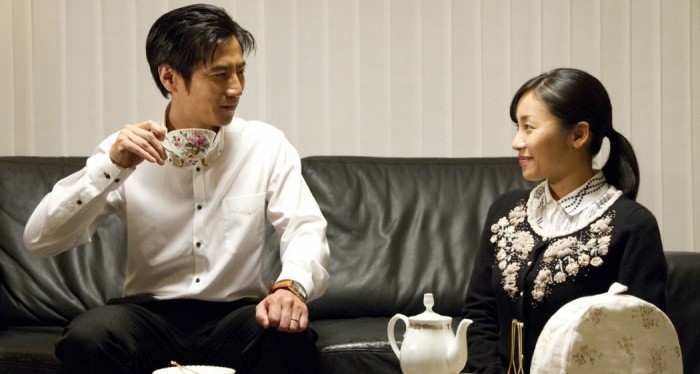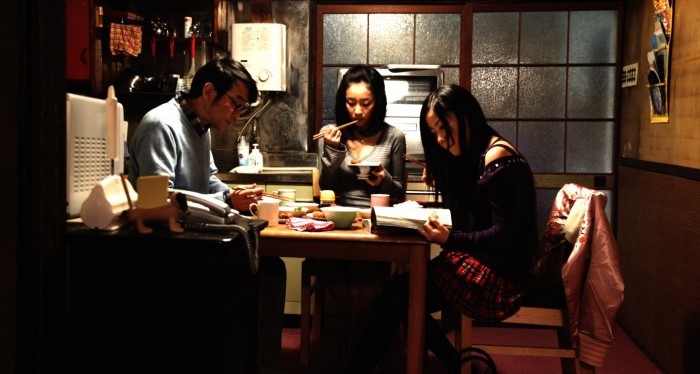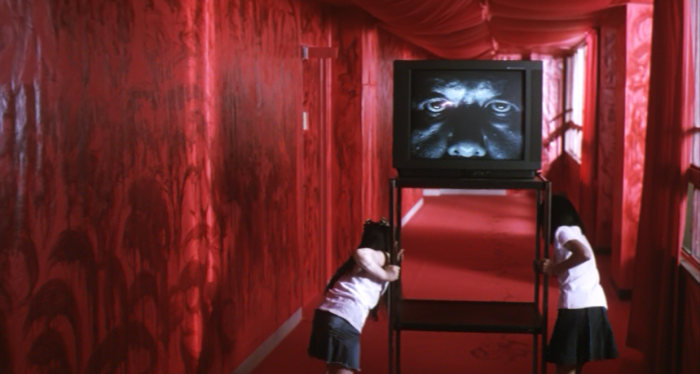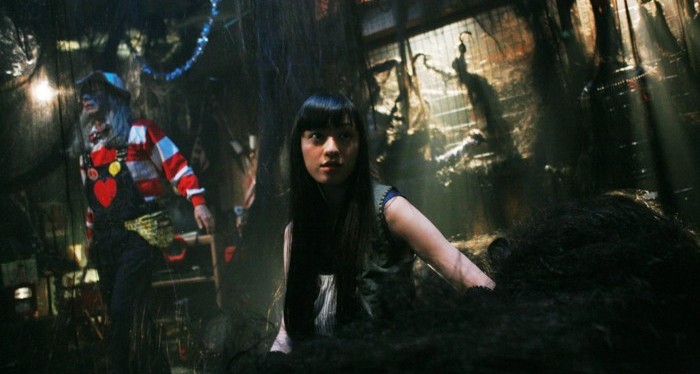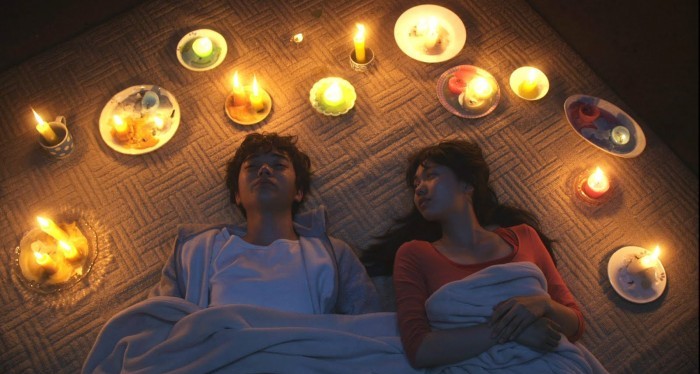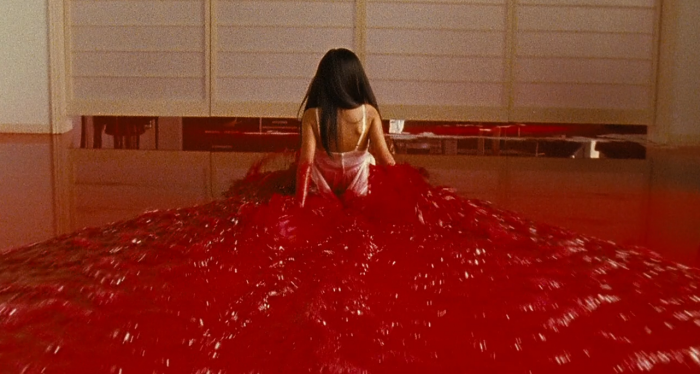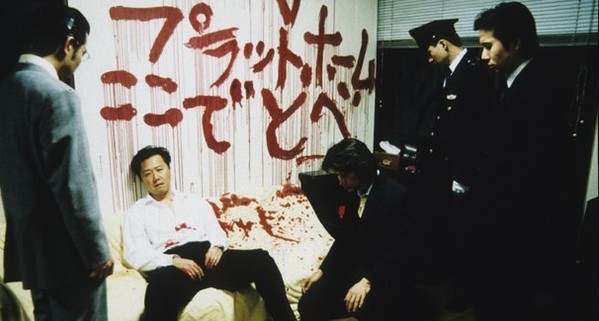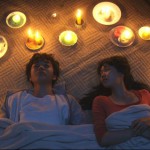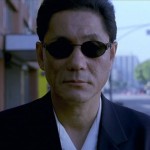Out of all the weird and bloody eccentrics to work in the ‘extreme’ end of Asian cinema in recent decades, arguably none has more consistently staked a claim to the title of ‘auteur’ than 54-year-old Sion Sono. While his films may offer all the violent pop appeal needed to satisfy any viewer for whom shocking works like Battle Royale and Ichi the Killer are the peak of Japanese cinema, Sono’s greatest features use their bizarre and gory packages as a means to more substantial ends that extend far beyond their initial rush of novelty.
Sometimes this hidden complexity can be a provocative attempt to confound the viewer. Films like Suicide Club and Strange Circus seem intentionally hard to get a firm grip on, as if Sono is trying to push viewers into admitting that there are some things in life that they just don’t understand. It’s a slipperiness in ideas that often falls right in sync with Sono’s psychological probing. His films regularly focus on confused, distraught, damaged individuals who appear uncertain of their identity. Social commentary comes in the form of characters and conflicts that embody a widespread suppression of lust, rage or depression. When seen in this light, Sono’s colourful displays of ugliness take on a self-reflexive quality, with their very excess comically reflecting the unbalanced mentalities that the director is investigating.
One exciting thing about Sono’s catalogue is that the ‘classics’, if any, have yet to be firmly decided upon. Granted, some films of his have certainly received more acclaim from audiences and critics alike than others, but there’s an unusual lack of unanimity regarding which of them will bear revisiting in the years to come, meaning that any one ranking of his works will barely be more or less controversial than any other. In the case of this particular list, the features that made it to the top of the heap were generally thought of as those that managed to build their strange and grotesque styles around inspired, expansive thematic content and sincere, usually very jaded emotions, utilising outlandish showmanship to channel even more outlandish ideas.
10. Guilty of Romance (2011)
The closest thing Sono’s ever made to an erotic thriller, Guilty of Romance opens with a murder scene that practically doubles as an art gallery, in which body parts are meshed with mannequin segments, and blood and red paint decorate the surroundings in equal measure. Already, the lines between the organic and the artificial, and human and commodity, are looking a little blurry, and the nightmarish film that follows only obfuscates things further. The wild centreless movement of the whole film seems to stand in opposition to the aesthetic sterility of the neurotically composed home of restless wife Izumi whose formal, sexless marriage to a seemingly perfectionist writer leaves her feeling emotionally oppressed and in need of an outlet for her lust and a chance in turn to be lusted for.
Izumi’s increasing promiscuity and eventual move into prostitution would seem like the basis of an old-fashioned cautionary tale had Sono’s depiction of it all had any clear boundaries between sex and violence, using and being used, sex for profit and sex for its own sake, the desire for someone and the desire to be someone, and rape and willing submission. Even the distinction between life and death starts to feel less consequential amid the increasing debauchery, but for all the film’s abandonments of morals and certainties for the sake of sexual freedom, carnal fulfilment remains out of reach. Naturally, it isn’t exactly clear what, if anything, you should be taking from all of this, but Guilty of Romance remains a dazzling match-up of subversive form and provocative content.
9. Cold Fish (2010)
Even by the standards of Sono’s habitually gruesome oeuvre, nihilistic psychodrama Cold Fish can be quite the stomach-turner. Just take the agonisingly drawn out disposal of the first of the film’s numerous corpses, vividly revealing how a man’s life can be reduced to a bag of mulch over the course of a single night before being dumped into the river at morning for the fish to finish off. You can practically smell the piles of cold dead flesh, and this figurative stench may prove overpowering for many a first time viewer.
But give this story of failed patriarchy a second chance and you may discover the genuine – albeit hardly more cheerful – feeling that lies beneath the depravity. Our sympathies treacherously lie with sexually frustrated fish entrepreneur Nobuyuki, the husband and father of an emotionally fragmented family that acts as a consistent enforcement of the crippling sense of inadequacy that Nobuyuki hides behind his modest façade. Burdened by emasculating morality and exasperated by society’s failure to deliver on its unrealistic promises of personal fulfilment and familial warmth, it’s shockingly easy to understand how this Walter White-esque antihero could be quickly corrupted by fellow fish salesman, Yukio, a man completely unbounded by instilled notions of selflessness.
Aided by a humorous and mockingly unpleasant performance from Denden, this irredeemable psycho is everything our lead isn’t and more successful for it, both financially and socially (his ‘cool uncle’ demeanour effortlessly wins over Nobuyuki’s bratty daughter). So when Nobuyuki’s own raging id finally comes to the surface, it feels all the more tragic that the carnage that follows only serves to solidify his status as a born loser. If there’s any lesson to be learned from Cold Fish, it’s probably best for everyone that you don’t learn it.
8. Strange Circus (2005)
The first 40 minutes of Strange Circus see Sono at his most colourful, oneiric and aesthetically unbounded, telling an engrossingly gothic tale of childhood trauma as the young Mitsuko suffers at the hands of an irredeemably sadistic father. With that in mind, the sudden turn into metafiction that the film takes at the end of this spellbinding opening act can only be taken as an act of sadism towards the audience, shrugging off all that came before it as the mere fabrication of a dishonest writer named Taeko. It is here that Strange Circus makes its true motivations clear, as a deceptive drama concerned with the relation between author, creation and fan, undermining simplistic notions of art as noble self-expression.
Just as Taeko’s admirer Yuji seems to have a more sincere connection to Taeko’s work than she does, we continue to care about the fate of Mitsuko even after the revelation that she is a fiction within a fiction designed by Taeko to push the buttons of susceptible consumers. For the remaining hundred minutes of the film, Sono brutally tests the limits of this emotional connection, consistently keeping the audience on their toes in reassessing the relative truth of Mitsuko’s world, while deftly evoking the egotistical, indulgent, exploitative nature of her novelist creator Taeko. Throughout the series of impulsive twists and narrative fake-outs, the director makes it unapologetically clear that he is the chief manipulator behind it all, eventually turning even Taeko’s deceitful nature upon herself in the film’s mockingly ambiguous conclusion. But with a ringleader as skilled as Sono, Strange Circus is a film that’s impossible to trust but a pleasure to experience.
7. The Land of Hope (2012)
A ghostly stillness haunts much of Sion Sono’s unusually mature Land of Hope, a potent, ambitious film that looks at the 2011 earthquake through older, less dread-filled eyes than those of the previous year’s Himizu. When a nuclear disaster necessitates an evacuation of the nearby area, a neighbourhood finds its existence uprooted and its mark on the world wiped away. Previously held notions of ‘country’ are diminished in the surreal aftermath, as citizens potentially exposed to radiation suddenly become lepers to their nation, and with answers withheld by the authorities, a full picture of the situation becomes impossible, leaving each anxious individual to face their own problems in their own way.
The film, in turn, offers no easy solutions but pensively and sympathetically observes its cast of characters as they navigate a land where even the air they breathe could be dangerous. The strangeness and tragedy of this reality allows Sono to bridge the gap between social commentary and a more abstract contemplation of family, mortality and the transitory nature of all things. With restraint and compassion, Sono evokes the adversities of Japan’s inescapable past to suggest that loss and hardship are inherent parts of the national identity, celebrating the persistence of the people as he laments the overarching forces, governmental and otherwise, that direct their lives. And while The Land of Hope certainly ventures into some bitter, haunting, even darkly comic territory, it balances out its fatalism with just enough human warmth to ensure that its title isn’t a complete lie.
6. Exte: Hair Extensions (2007)
Rarely have the glamourous and the grotesque seemed more like two sides of the same coin than in Sion Sono’s deceptively clever Exte, a sharp, subversive study of the different forms of fetishism dressed in a creepy ghost story package. The film’s primary trick is presenting its most obvious object of passion, hair, in overwhelming excess, displacing it to the point of being utterly devoid of sensual appeal. Hair is found stuffed inside a corpse’s interior, coming out of a woman’s eye and decorating the furniture in wildly inventive sets and sequences that strip hair of its role as accessory and reduces it to something purely physical and biological.
But in the process of undermining one fetish, Exte inevitably indulges in another, presenting gruesome, tensely edited spectacles of death and perversion that will have enthusiasts for the macabre salivating. This ingenious dichotomy of ugly beauty and beautiful ugliness is no accident. Just as crude, everyday narcissism is contrasted with lead Yuko’s tasteful appreciation for the craft of hairdressing, the outrageous, often humorous CGI and stop motion set pieces are placed alongside the real life horrors of domestic abuse. Throw in some droll nods to the clichés and mechanisms of cinema itself (most notably the knowingly forced exposition of Yuko’s introductory scene) and you’ve got one of Sono’s most expansive pop culture visions – one that incorporates not just hair and beauty, but also the J-horror genre and the entertainment industry in general, tangling every escapist extreme of the millennial mindset into a single inextricable knot.
5. Himizu (2011)
Opening with the rust and wreckage of a tsunami-struck Japan, Sono’s Himizu uses its two excellent young leads to suggest disparate responses to personal and national hardships, with Sumida and Keiko together embodying both the pessimism and idealism that we associate with youth. In the process of adapting to his strained circumstances, Sumida loses all sense of self-worth and ambition beyond a misanthropic drive to rid the world of all the creeps and psychos with whom he no doubt empathises. The highly analytical Keiko, on the other hand, attempts to block out her sorrows with excessive cheeriness, feeling the need to fill any awkward silence with encouraging mantras or cutesy diversions, even making a quirky game out of her anger towards Sumida by putting one stone in her pocket for every time he wrongs her. In the parody of a domestic life that they lead together, Sumida pushes Keiko further than most people would tolerate, but she keeps coming back to him, and one suspects that this is in part because this crush of hers is the strongest connection that the introverted, stalker-ish Keiko has to the world around her.
It’s a fascinating central dynamic to a refreshingly original commentary on the weight that falls on each new generation. Sono enriches their bleak surroundings with the types of monsters that society births, while Sumida’s brave-faced, post-tsunami surrogate family cheer him on with insistent smiles, but cower impotently when Sumida’s own father beats him. It’s clear that most of the world is either unable or unwilling to give Keiko or Sumida a leg up, a situation often conveyed with resigned gallows humour – specifically, a gallows in Keiko’s house that her parents lovingly paint red and decorate with Christmas lights. But thanks to the inviting performances and sympathetic characterisations of the film’s two young, downtrodden protagonists, Himizu remains one of its director’s most accessibly human works.
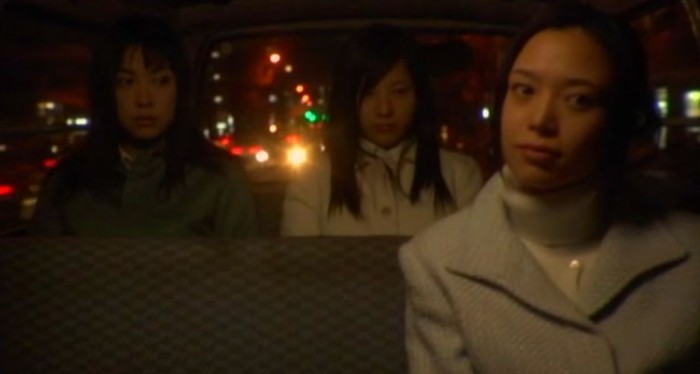
4. Noriko’s Dinner Table (2005)
For those of us who relished the teasing ambiguities of 2001’s Suicide Club, this so-called prequel to Sono’s cult classic risked serving as an unwelcome demystification, filling in the harrowing and humorous blanks with buzz-killing literal-mindedness. Luckily, Noriko’s Dinner Table manages to stay true to the dark cosmic comedy and psychological horror of its predecessor, putting more effort into creating troubling new riddles than answering the old ones. Building on the information age ruminations hinted at in Suicide Club, Noriko’s Dinner Table’s endearing eponymous protagonist uses the web as a medium for reinvention and to find anonymous companionship. Neither she nor anyone she speaks to uses their real name, but the sense of community Noriko develops with her new friends feels real enough for her to leave her actual family and run away to Tokyo, closely followed by her sister Yuka.
Dedicating much of its runtime to the detective work of distraught father Tetsuzo as he attempts to track down his two evidently brainwashed children, Noriko’s Dinner Table is a shade more external and interpersonal than Suicide Club in its observations of the same dread-ridden mindset suggested by that film. Sono mournfully depicts the despair of watching a loved one vanish into the abyss, drawn away by thoughts they never revealed to you and that you would never be able to understand anyway, but more resonant is the creeping uncertainty Sono creates about the roles we play in life, the families we make for ourselves and the people we become. The poignant, uncomfortably funny final half hour in particular feels like a transcendent expansion on Suicide Club’s questions regarding connectivity to the people around you and to yourself, using a mock family dinner as the setting for an eerie immersion into the uncanny and a tense battle of minds on the strangest of abstract playing fields. A deconstructive family drama that operates by its own off-kilter logic, this may well be Sion Sono’s greatest identity crisis.
3. Why Don’t You Play in Hell? (2013)
With its eccentric aesthetics, cartoonish mob warfare, violent slapstick and oceans of blood, Why Don’t You Play in Hell? feels like a dark reality filtered through the juvenile sensibilities of renegade film crew the Fuck Bombers, the idealistic cinephiles who finally get their big break collaborating with the local yakuza to make a self-glamorising mob flick complete with real onscreen deaths. Both portraying and embodying the joy of filming and being filmed, this is a raucous, romantically youthful picture that has grindhouse-level movie-love practically dripping from its pores.
For anyone who’s experienced their fair share of B-movie pastiches and post-Tarantino novelty flicks, Why Don’t You Play in Hell? is a more satisfying watch than it has any right to be. With each euphoric sequence delivered, part of you waits nervously for the moment where the mayhem finally runs out of steam and descends into tired, desperate gimmickry (sees Sono’s own Tokyo Tribe). With its 129 minute runtime, you figure that surely this work of jubilant silliness must be at least half an hour too long (again, Tokyo Tribe). And yet, the sugar high sustains right the way through to the fatality-heavy finish, providing perhaps the strongest case possible for Sono’s technical mastery. So while Why Don’t You Play in Hell? may be neither the director’s best nor most complex work, it just might be the closest he’s ever come to making a perfect film, supplying enough big screen ecstasy to make you wonder why Hollywood blockbusters are even a thing.
2. Suicide Club (2001)
Sion Sono’s response to Japan’s unusually high suicide rate is an overwhelming, at times confounding film that bursts at the seams with unnerving ideas and contradicting emotions, presenting existence as a grim cosmic joke that we may all be subconsciously in on. It’s a crime film with no criminals to catch, evoking a feeling of helplessness as Kuroda and his fellow lawmen struggle ineffectually to make sense of a growing wave of self-destruction, unable to save anyone from their own death drive. The seemingly untraceable horror that gives new dread to the sight of an approaching train or the sound of a pre-teen pop song may start off looking like a problem of youth, possibly one of mob mentality, but a grisly mid-film montage expands Sono’s surreal vision to encompass all walks of life, rendering everyone from the local comedy club duo to Kuroda’s own spouse and children beyond protection.
Much like Kiyoshi Kurosawa’s J-horror masterpiece Pulse from the same year, Suicide Club seems informed by philosophical questions raised in the early years of the Information Age regarding our connection to the world, ourselves and others, tying this in with some worrying thoughts on the nature of free will, or the illusion of such. It’s a lonely, humorous and profoundly gruesome work that refuses to clarify its frighteningly formless horror on a psychological, sociocultural or even basic causal level, suggesting only an unpulled trigger at the back of every person’s mind or a sinister presence lurking backstage to the theatre of reality.
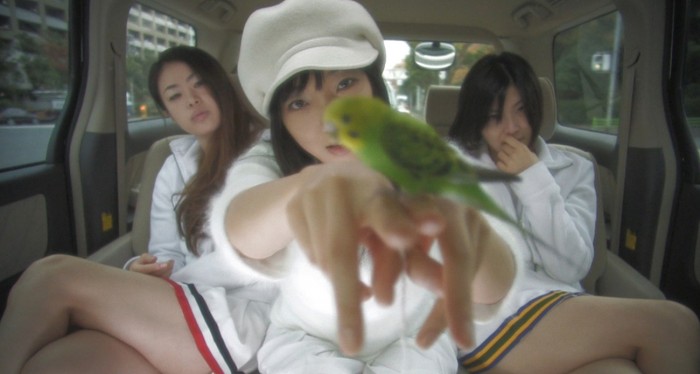
1. Love Exposure (2008)
Have you ever stopped to marvel at how lucky we are to even live in a world with a 4-hour film as beautifully sacrilegious, operatically crude and gleefully inappropriate as Love Exposure? A comfortable candidate for best coming-of-age film of recent decades, this giddy celebration of sexual awkwardness and pop culture dorkery manages to indulge in just about every fantasy of the young adolescent mind even as it thoughtfully examines the implications of what it’s showing, taking on the roles of psychiatrist and fast-talking patient alike.
Its narrative of sexual repression, religious shaming, up-skirt photography and domestic abuse will make sense only to the most immature at heart, taking the biggest emotions of the teen years – angst, loneliness, lust, humiliation – and using them to drive a kaleidoscopic fiction that moves from horny boys’ adventure to dark psychological thriller to sinister cult story in a vibrant world of outlandish solutions to confusing problems created by damaged psyches. Only in the mind of your average lonely high schooler is a master up-skirt photographer looked up to as an authoritative sensei while love is equivalent to a comically large boner (i.e. ‘becoming erect in your heart’).
Packing enough plot for a movie twice its length, Love Exposure races through its events like a passionate tour guide who desperately needs to pee, yet this is still one of the most cohesive works Sono has put out thus far because the film never loses focus in its epic account of the bewildering formative years of sexuality and morality. The film may dedicate its longest take to a recital of 1 Corinthians 13, presenting a more mature perspective on the nature of love that profoundly contrasts with the boyish naiveté that dominates the feature (it’s crucial to the film’s portrayal of coy, distant lust that no one but the parents in the entire 4 hours actually gets laid). But thank God that Sion Sono never learned to put away childish things, because otherwise we may never have got such a rich, invigorating career of meaningful outrageousness and inventive brutality, nor would we have got the closing minutes of Love Exposure, which deliver what can be confidently described as one of the greatest erection-related climaxes in cinema history.
Watch Now on FilmDoo:
(UK & Ireland only)
Find more Japanese films here.

